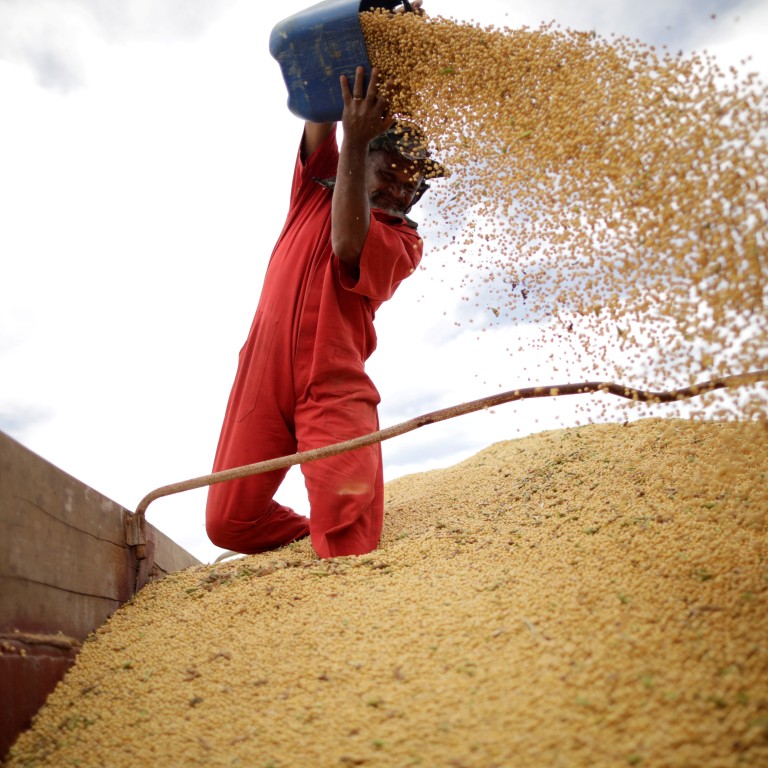
Trade war: US soybean farmers anxiously await China deal, but Brazil, Argentina exporters hope for ‘no deal’
- Donald Trump said US-China deal in ‘final throes’, but the clock is ticking for farmers in the United States who may lose out to incoming crops from South America
- Argentinian trader said that farmers are hoping for ‘no deal’ in the hope that its strong exports to China can continue
The clock is ticking for American soybean farmers, who are anxious to cash in on the bumper payday of a “phase one” US-China trade deal, before South American crops become available early next year.
Brazilian and Argentinian beans will be on the market by late-February, analysts said, meaning that US farmers could miss out to their southern hemispheric rivals if a deal is not reached before then. Both sides have intimated that a deal is close, but as yet, there is no signing ceremony in the works.
If [China]-US trade talks drag on for another two months, US farmers will miss the best sales chance to China in the new marketing year
“New soybean crops from South America could exactly meet the demand in the Chinese market,” said a report from Shanghai JC Intelligence this week. “If [China]-US trade talks drag on for another two months, US farmers will miss the best sales chance to China in the new marketing year. Those unsold soybeans will further add to US soybean stocks.”
Argentina and Brazil have been making hay while the US has been largely absent from Chinese markets over the past 16 months. Hefty tariffs have seen US soybean sales to China fall by 90 per cent since 2017, largely replaced by imports from Brazil. The South American nation is expected to harvest a crop 27 per cent bigger than the US this year, according to agricultural data provider Gro Intelligence.
Their report said that as recently as 2015, output from the US was 10 per cent bigger than Brazil, with China proposing “a billion-dollar investment in Brazilian infrastructure to secure long-term supply of the soybeans it needs”.
Argentina has come back in a major way, after drought destroyed the 2018 crop. China bought more than 6 million metric tonnes (13 billion pounds) of Argentinian beans this year, out of its total demand of roughly 85 million metric tonnes (187 billion pounds). In October, almost 100 per cent of Argentina’s soybean exports went to China, AgriCensus reported.
Argentina is also expecting a bumper crop in 2020, with farmers hoping trade negotiators’ efforts to reach a deal continue to be frustrated.
“Conditions are still very good,” said Rogier Kievet, a soybean trader at Agree Market in Argentina. “For the farmers, no deal would be great.”
In September, China opened its market to soymeal livestock feed from Argentina for the first time, described by exporters in Buenos Aires as a “historic agreement”. The country is the world’s largest shipper of meal, whereas China had previously preferred to crush soybeans domestically, since the value-adding processes of making oil and meal can then be carried out on Chinese soil.
For the crushers [no deal] will not be that nice
“For the crushers [no deal] will not be that nice. Even with the deal, China can import Argentinian meal and oil but my feeling is that the Chinese will prefer crushing locally instead of [importing] finished products,” Kievet added, implying that a return of raw US soybean exports to China’s market could kill the emerging trade.
US farmers will be thankful for the dryer growing season in both countries this year, since it may give more wiggle room for a trade deal. Brazilian and Argentinian soybeans were on the market by late-January 2019, in a “particularly early harvest”, analysts said.
“US farmers are sitting on beans in hopes of a signed phase one trade agreement, but the South American harvest is rapidly approaching,” said Rob Hatchett, senior economist at Doane Advisory Services, a research house in Tennessee.
“Another concern is that there have been reports of issues offloading soybean arrivals at Chinese ports due to congestion – soybeans are not moving to processors as quickly as they need to.”
Earlier in November, Reuters reported that China’s stat buyers had increased purchases of US beans, even as a bottleneck held previous cargoes up at the port amid a dispute over tariff payments.
China increased its orders of US soybeans by 25 per cent last week, US Department of Agriculture data showed.
Trump also invoked an obscure 1940s law to bypass Congress this week, in order to distribute US$20 billion in aid to farmers in key electoral states, a sign of his desire to win the crucial Farm Belt vote. In many cases, however, the situation is dire, with aid distributed unevenly and not covering the cost of wasted crops that would have been otherwise bound for China.
The number of farms filing for bankruptcy in 2018 increased 41.6 per cent, year on year, while in the first quarter of 2019, bankruptcies were at the highest rate since 2012.

